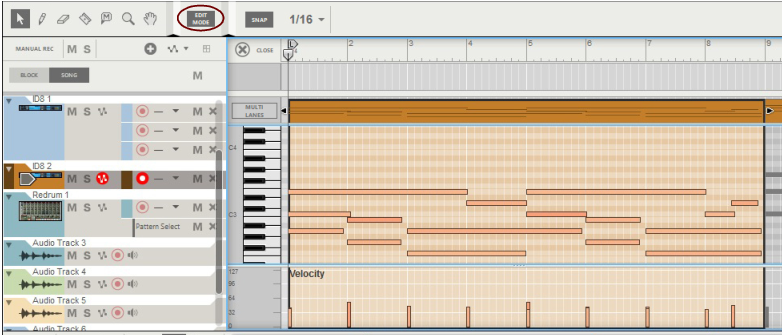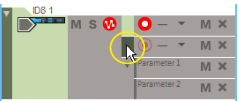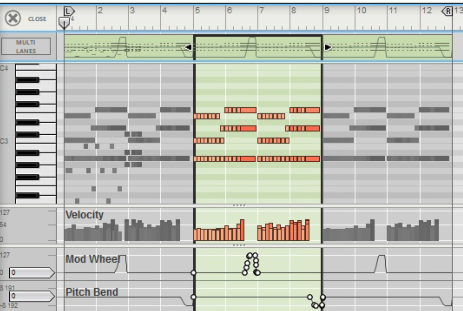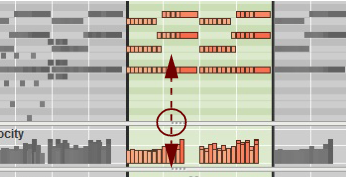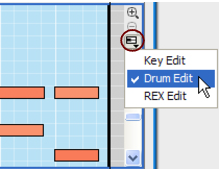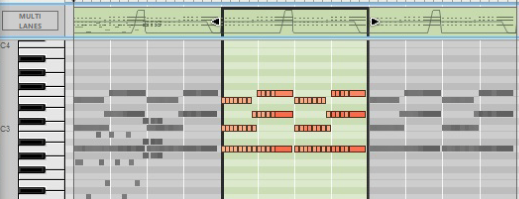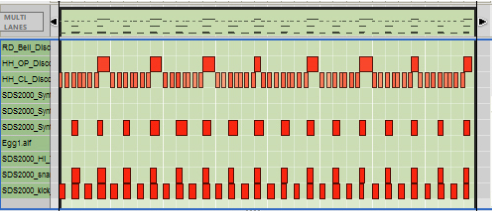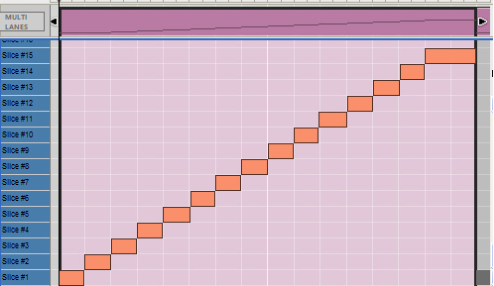The Edit Mode shows the contents of a single lane at a time on the Edit Pane - unless you use the Multi Lanes function, described in “Multi Lanes editing”, where you can see the contents of multiple note lanes in a “ghosted” fashion underneath the currently open clip. On instrument tracks, only one note lane can have edit focus at a time.
Also, all parameter automation lanes will be shown at the bottom of the Edit Pane. If a single clip was selected on the note lane with edit focus when you switched to Edit Mode, it will automatically be opened. If no clip was selected, the events will be grayed out. To be able to edit or draw notes and/or automation events, you need to open the clip, for example by double-clicking it (see “Opening note and automation clips for editing”).
Note clips can contain both note events - with velocity values - and performance controller events. By default, performance controllers include Mod Wheel, Pitch Bend, Sustain Pedal, Aftertouch, Expression and Breath Controller. However, the controller configuration can easily be changed (see “Creating new performance controller automation lanes” and “Deleting performance controller automation lanes”).
See “Editing parameter automation in the Song/Block View” for information on how to edit parameter automation events in the Song/Block View.
See “Editing parameter automation in Edit Mode” for information on how to edit parameter automation events in Edit Mode.
To the right of the Note Edit Lane, below the Vertical Zoom tools, is the Note Edit Mode Selector. Click to choose between Key Edit, Drum Edit or REX Edit Mode. Depending on selected mode, the Note Edit Lane will display differently. See more about the different modes in “Note Edit Modes”.
Each performance controller you used when recording the note clip has its own separate Performance Controller Edit Lane. You can add or delete performance controller edit lanes from the clip using this selector. See the “Creating new performance controller automation lanes” and “Deleting performance controller automation lanes” for more details.
Here you can edit the notes of one open clip at a time. Note events are displayed as orange horizontal “boxes” in a piano roll fashion on the Note Edit Lane. The left side of each box indicates Note On (key down) and the right side Note Off (key up). The color intensity of each box indicates the velocity for the corresponding note. Depending on selected Note Edit Mode (see “Note Edit Modes”), the contents of the Note Edit Lane will display differently.
The Velocity Edit Lane shows the velocity values for each of the recorded notes. Velocity values are automatically recorded together with notes. See more about editing velocity values in “Editing note velocity”.
On the Performance Controller Edit Lanes are the performance controller events for Mod Wheel, Pitch Bend, Sustain Pedal etc. Performance controller events are automatically distributed on separate lanes for each recognized controller during recording. Even though performance controllers belong to separate note clips, they will affect all active parallel note lanes on a track. See “Automation editing” for details on how to edit performance controller events.
Any recorded parameter automation will be shown in separate clips, on separate Parameter Automation Lanes. Parameter automation clips don’t “belong” to the note lane or to any note clips, and will not be opened together with note clips. Double-clicking on a parameter automation clip will open it for editing. See “Automation editing”.
The Static Value Handles to the left of the Performance Controller Edit Lanes and Parameter Automation Lanes indicate to what value the automated controller/parameter will default to where there are no clips on the lane. Basically, this value reflects the parameter’s initial value, before it was automated. You can easily change a parameter’s Static Value by dragging the Static Value Handle up or down. See “Automation editing” for more details.
|
|
|
|
|
|
|
•
|
